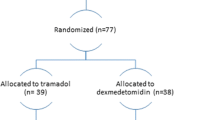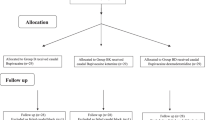Abstract
Purpose
Oral midazolam is frequently used to treat children, but its effect on recovery from anesthesia is controversial. This study was designed to evaluate the effect of flumazenil on reversal of midazolam during recovery from sevoflurane-induced anesthesia in children who underwent caudal analgesia compared to those who did not.
Methods
A series of 60 children 1–8 years of age, with an American Society of Anesthesiologists (ASA) physical status of 1 or 2, who were scheduled to undergo herniorrhaphy were randomly assigned to one of four groups: group 1, control/placebo; group 2, control/flumazenil; group 3, caudal/placebo; group 4, caudal/flumazenil. After oral administration of midazolam 0.5 mg · kg−1, anesthesia was induced and maintained with sevoflurane and nitrous oxide in oxygen via a face mask with spontaneous ventilation. The time from the discontinuation of anesthetics to emergence was recorded, and at the time of discharge from the operating room each patient’s recovery characteristics were assessed using a three-point scale.
Results
Emergence from anesthesia was significantly less agitated in the group of children who underwent caudal analgesia without flumazenil compared to the other three groups. Flumazenil shortened the time to emergence regardless of the application of caudal analgesia, and caudal analgesia delayed the time to emergence regardless of flumazenil administration.
Conclusion
Caudal analgesia and avoiding the use of flumazenil synergistically resulted in the emergence from anesthesia in a less agitated state for children who underwent herniorrhaphy after oral midazolam premedication.
Similar content being viewed by others
References
BC Weldon MF Watcha PF White (1992) ArticleTitleOral midazolam in children: effect of time and adjunctive therapy Anesth Analg 75 51–55
CO McMillan IA Spahr-Schopfer N Sikich E Hartley J Lerman (1992) ArticleTitlePremedication of children with oral midazolam Can J Anaesth 39 545–550
A McCluskey GH Meakin (1994) ArticleTitleOral administration of midazolam as a premedicant for paediatric day-case anaesthesia Anaesthesia 49 782–785
SH Cray JL Dixon CMB Heard DS Selsby (1996) ArticleTitleOral midazolam premedication for paediatric day case patients Paediatr Anaesth 6 265–270
SL Lapin SM Auden LJ Goldsmith AM Reynolds (1999) ArticleTitleEffects of sevoflurane anaesthesia on recovery in children: a comparison with halothane Paediatr Anaesth 9 299–304
YP Ko CJ Huang YC Hung NY Su PS Tsai CC Chen CR Cheng (2001) ArticleTitlePremedication with low-dose oral midazolam reduces the incidence and severity of emergence agitation in pediatric patients following sevoflurane anesthesia Acta Anaesthesiol Sin 39 169–177
H Viitanen P Annila M Viitanen P Tarkkila (1999) ArticleTitlePremedication with midazolam delays recovery after ambulatory sevoflurane anesthesia in children Anesth Analg 89 75–79
RDM Jones AD Lawson LJ Andrew WMS Gunawardene J Bacon-Shone (1991) ArticleTitleAntagonism of the hypnotic effect of midazolam in children: a randomized, double-blind study of placebo and flumazenil administered after midazolam-induced anaesthesia Br J Anaesth 66 660–666
M Shannon G Albers K Burkhard E Liebelt M Kelley MM McCubbin J Hoffman J Massarella InstitutionalAuthorNameFlumazenil Pediatric Study Group (1997) ArticleTitleSafety and efficacy of flumazenil in the reversal of benzodiazepine-induced conscious sedation J Pediatr 131 582–586
M Massanari J Novitsky LJ Reinstein (1997) ArticleTitleParadoxical reactions in children associated with midazolam use during endoscopy Clin Pediatr 36 681–684
AA Weinbroum O Szold D Ogorek R Flaishon (2001) ArticleTitleThe midazolam-induced paradox phenomenon is reversible by flumazenil: epidemiology, patient characteristics and review of the literature Eur J Anaesthesiol 18 789–797
J Lerman PJ Davis LG Welborn RJ Orr M Rabb R Carpenter E Motoyama R Hannallah CM Haberkern (1996) ArticleTitleInduction, recovery, and safety characteristics of sevoflurane in children undergoing ambulatory surgery: a comparison with halothane Anesthesiology 84 1332–1340
PJ Davis JA Greenberg M Gendelman K Fertal (1999) ArticleTitleRecovery characteristics of sevoflurane and halothane in preschool-aged children undergoing bilateral myringotomy and pressure equalization tube insertion Anesth Analg 88 34–38
JL Galinkin LM Fazi RM Cuy RM Chiavacci CD Kurth UK Shah IN Jacobs MF Watcha (2000) ArticleTitleUse of intranasal fentanyl in children undergoing myringotomy and tube placement during halothane and sevoflurane anesthesia Anesthesiology 93 1378–1383
AR Wolf RD Valley DW Fear WL Roy J Lerman (1988) ArticleTitleBupivacaine for caudal analgesia in infants and children: the optimal concentration Anesthegiology 69 102–106
RDM Jones K Chan CJ Roulson AG Brown ID Smith GH Mya (1993) ArticleTitlePharmacokinetics of flumazenil and midazolam Br J Anaesth 70 286–292
K Payne FJ Mattheyse D Liebenberg T Dawes (1989) ArticleTitleThe pharmacokinetics of midazolam in paediatric patients Eur J Clin Pharmacol 37 267–272
RDM Jones AR Visram JP Kornberg MG Irwin WMS Gunawardene (1994) ArticleTitlePremedication with oral midazolam in children: an assessment of psychomotor function, anxiolysis, sedation and pharmacokinetics Anaesth Intensive Care 22 539–544
Author information
Authors and Affiliations
Additional information
This study was presented in part at the International Anesthesia Research Society’s 77th Clinical and Scientific Congress, New Orleans, March 22, 2003
About this article
Cite this article
Araki, H., Fujiwara, Y. & Shimada, Y. Effect of flumazenil on recovery from sevoflurane anesthesia in children premedicated with oral midazolam before undergoing herniorrhaphy with or without caudal analgesia. J Anesth 19, 204–207 (2005). https://doi.org/10.1007/s00540-005-0314-4
Received:
Accepted:
Issue Date:
DOI: https://doi.org/10.1007/s00540-005-0314-4




